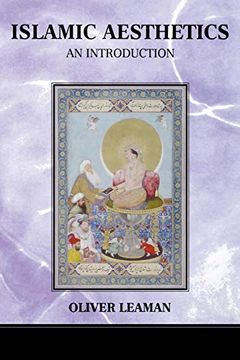Reseña del libro "Islamic Aesthetics: An Introduction (en Inglés)"
It is often argued that a very special sort of consciousness went into creating Islamic art, that Islamic art is very different from other forms of art, that Muslims are not allowed to portray human beings in their art, and that calligraphy is the supreme Islamic art form. Oliver Leaman challenges all of these ideas, and argues that they are misguided. Instead, he suggests that the criteria we should apply to Islamic art are identical to the criteria applicable to art in general, and that the attempt to put Islamic art into a special category is a result of orientalism.Leaman criticizes the influence of Sufism on Islamic aesthetics and contends that it is generally misleading regarding both the nature of Islam and artistic expression. He discusses issues arising in painting, calligraphy, architecture, gardens, literature, films, and music and pays close attention to the teachings of the Qur’an. In particular he asks what it would mean for the Qur’an to be a miraculous literary creation, and he analyzes two passages in the Qur’an―those of Yusuf and Zulaykha (Joseph and Zuleika) and King Sullayman (Solomon) and the Queen of Sheba. His arguments draw on examples from history, art, philosophy, theology, and the artefacts of the Islamic world, and raise a large number of difficulties in the accepted paradigms for analyzing Islamic art. Leer más Leer menos P.when('DynamicIframe').execute(function(DynamicIframe){ var BookDescriptionIframe = null, bookDescEncodedData = "%3Cp%3EIt%20is%20often%20argued%20that%20a%20very%20special%20sort%20of%20consciousness%20went%20into%20creating%20Islamic%20art%2C%20that%20Islamic%20art%20is%20very%20different%20from%20other%20forms%20of%20art%2C%20that%20Muslims%20are%20not%20allowed%20to%20portray%20human%20beings%20in%20their%20art%2C%20and%20that%20calligraphy%20is%20the%20supreme%20Islamic%20art%20form.%20Oliver%20Leaman%20challenges%20all%20of%20these%20ideas%2C%20and%20argues%20that%20they%20are%20misguided.%20Instead%2C%20he%20suggests%20that%20the%20criteria%20we%20should%20apply%20to%20Islamic%20art%20are%20identical%20to%20the%20criteria%20applicable%20to%20art%20in%20general%2C%20and%20that%20the%20attempt%20to%20put%20Islamic%20art%20into%20a%20special%20category%20is%20a%20result%20of%20orientalism.%3C%2Fp%3E%3Cp%3ELeaman%20criticizes%20the%20influence%20of%20Sufism%20on%20Islamic%20aesthetics%20and%20contends%20that%20it%20is%20generally%20misleading%20regarding%20both%20the%20nature%20of%20Islam%20and%20artistic%20expression.%20He%20discusses%20issues%20arising%20in%20painting%2C%20calligraphy%2C%20architecture%2C%20gardens%2C%20literature%2C%20films%2C%20and%20music%20and%20pays%20close%20attention%20to%20the%20teachings%20of%20the%20Qur%E2%80%99an.%20In%20particular%20he%20asks%20what%20it%20would%20mean%20for%20the%20Qur%E2%80%99an%20to%20be%20a%20miraculous%20literary%20creation%2C%20and%20he%20analyzes%20two%20passages%20in%20the%20Qur%E2%80%99an%E2%80%95those%20of%20Yusuf%20and%20Zulaykha%20%28Joseph%20and%20Zuleika%29%20and%20King%20Sullayman%20%28Solomon%29%20and%20the%20Queen%20of%20Sheba.%20His%20arguments%20draw%20on%20examples%20from%20history%2C%20art%2C%20philosophy%2C%20theology%2C%20and%20the%20artefacts%20of%20the%20Islamic%20world%2C%20and%20raise%20a%20large%20number%20of%20difficulties%20in%20the%20accepted%20paradigms%20for%20analyzing%20Islamic%20art.%3C%2FP", bookDescriptionAvailableHeight, minBookDescriptionInitialHeight = 112, options = {}, iframeId = "bookDesc_iframe"; function resizeCallback() { P.guardFatal("bookDescription", function() { // Get the line-height of the iframe var iframe = document.getElementById(iframeId); var iframeDocument = iframe.contentDocument; if (false && iframeDocument && iframeDocument.defaultView) { // Set the height to the number of lines specified var numLines = parseInt(0, 10); // Get the line-height of the iframe var iframeContent = iframeDocument.getElementById("iframeContent"); // Compute the line height var lineHeight = iframeDocument.defaultView.getComputedStyle(iframeContent, null).getPropertyValue("line-height"); // Parse the line height lineHeight = parseFloat(lineHeight); bookDescriptionAvailableHeight = Math.round(lineHeight * numLines); } else { var bdOffsetTop = document.getElementById("bookDescription_feature_div").offsetTop; var imageBlockOffsetTop = document.getElementById("booksImageBlock_feature_div").offsetTop; var imageBlockHeight = document.getElementById("booksImageBlock_feature_div").offsetHeight; bookDescriptionAvailableHeight = imageBlockOffsetTop + imageBlockHeight -bdOffsetTop - 30; if(bookDescriptionAvailableHeight bookDescriptionAvailableHeight + 30){ if(document.getElementById("bdSeeLessPrompt").style.display == "none"){ document.getElementById("outer_postBodyPS").style.height = bookDescriptionAvailableHeight + 'px'; document.getElementById("psPlaceHolder").style.display ="block"; document.getElementById("bdSeeAllPrompt").style.display ="block"; } else{ document.getElementById("outer_postBodyPS").style.height = psTotalHeight + 'px'; } } else{ document.getElementById("outer_postBodyPS").style.height = psTotalHeight + 'px'; document.getElementById("psPlaceHolder").style.display ="none"; document.getElementById("bdSeeAllPrompt").style.display ="block"; document.getElementById("bdSeeLessPrompt").style.display ="none"; document.getElementById("bdExpanderIcon").className = document.getElementById("bdExpanderIcon").className.replace("rotate",""); } })(); } options.iframeId = iframeId; options.iframeWrapperId = "bookDesc_iframe_wrapper"; options.overriddenCSSId = "bookDesc_override_CSS"; options.encodedIframeContent = bookDescEncodedData; options.initialResizeCallback = resizeCallback; BookDescriptionIframe = new DynamicIframe(options); P.guardFatal("bookDescription", function() { BookDescriptionIframe.createIframe(); }) (); if ((typeof BookDescriptionIframe != 'undefined') && (BookDescriptionIframe instanceof DynamicIframe)) { P.when('jQuery').execute(function($) { $(window).resize(function() { P.guardFatal("bookDescription", function() { BookDescriptionIframe.resizeIframe(resizeCallback); }) (); }); $(window).bind('imageResize', function() { P.guardFatal("bookDescription", function() { BookDescriptionIframe.resizeIframe(resizeCallback); }) (); }); }); } });

